radiator cap DODGE CHARGER 2018 Owners Manual
[x] Cancel search | Manufacturer: DODGE, Model Year: 2018, Model line: CHARGER, Model: DODGE CHARGER 2018Pages: 553, PDF Size: 5.3 MB
Page 344 of 553
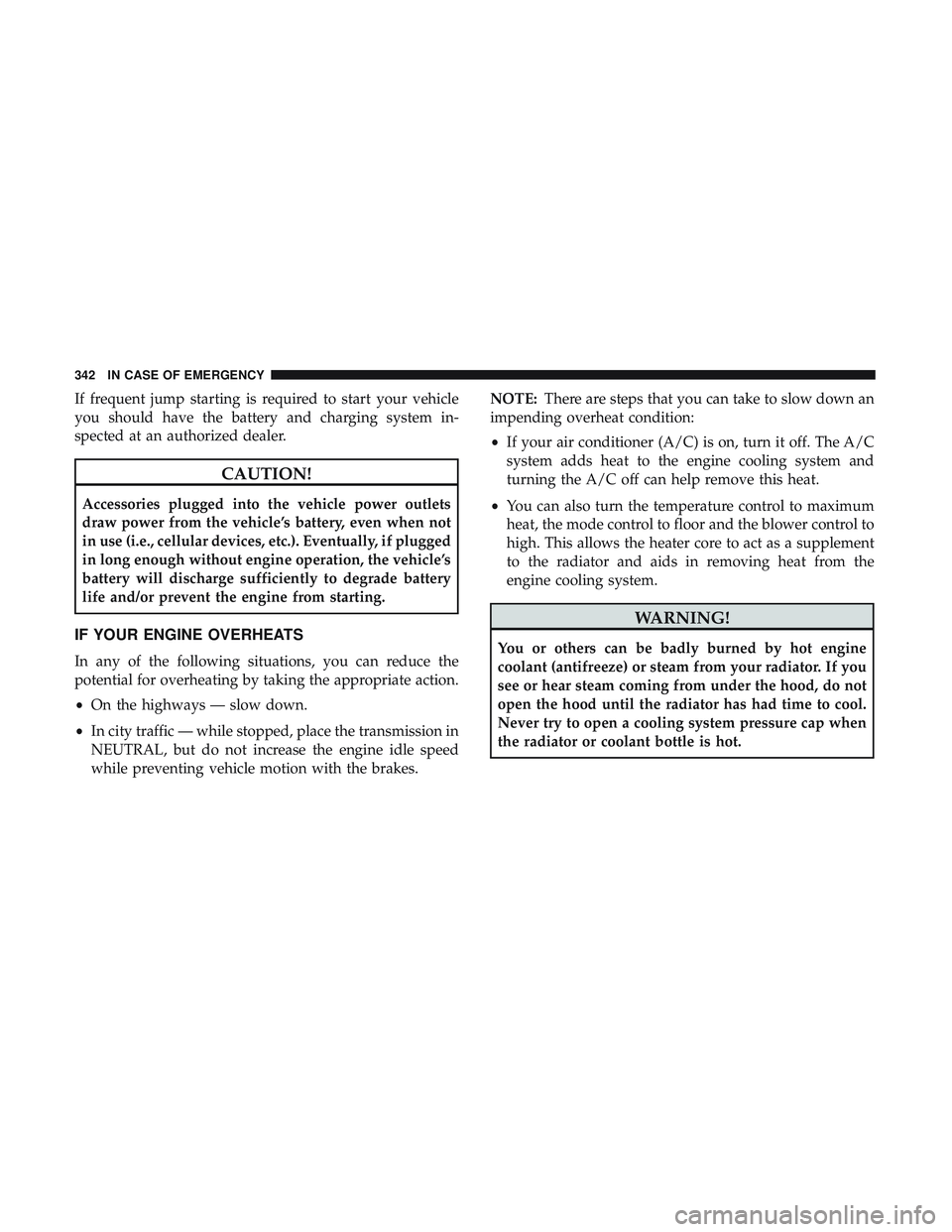
If frequent jump starting is required to start your vehicle
you should have the battery and charging system in-
spected at an authorized dealer.
CAUTION!
Accessories plugged into the vehicle power outlets
draw power from the vehicle’s battery, even when not
in use (i.e., cellular devices, etc.). Eventually, if plugged
in long enough without engine operation, the vehicle’s
battery will discharge sufficiently to degrade battery
life and/or prevent the engine from starting.
IF YOUR ENGINE OVERHEATS
In any of the following situations, you can reduce the
potential for overheating by taking the appropriate action.
•On the highways — slow down.
• In city traffic — while stopped, place the transmission in
NEUTRAL, but do not increase the engine idle speed
while preventing vehicle motion with the brakes. NOTE:
There are steps that you can take to slow down an
impending overheat condition:
• If your air conditioner (A/C) is on, turn it off. The A/C
system adds heat to the engine cooling system and
turning the A/C off can help remove this heat.
• You can also turn the temperature control to maximum
heat, the mode control to floor and the blower control to
high. This allows the heater core to act as a supplement
to the radiator and aids in removing heat from the
engine cooling system.
WARNING!
You or others can be badly burned by hot engine
coolant (antifreeze) or steam from your radiator. If you
see or hear steam coming from under the hood, do not
open the hood until the radiator has had time to cool.
Never try to open a cooling system pressure cap when
the radiator or coolant bottle is hot.
342 IN CASE OF EMERGENCY
Page 382 of 553
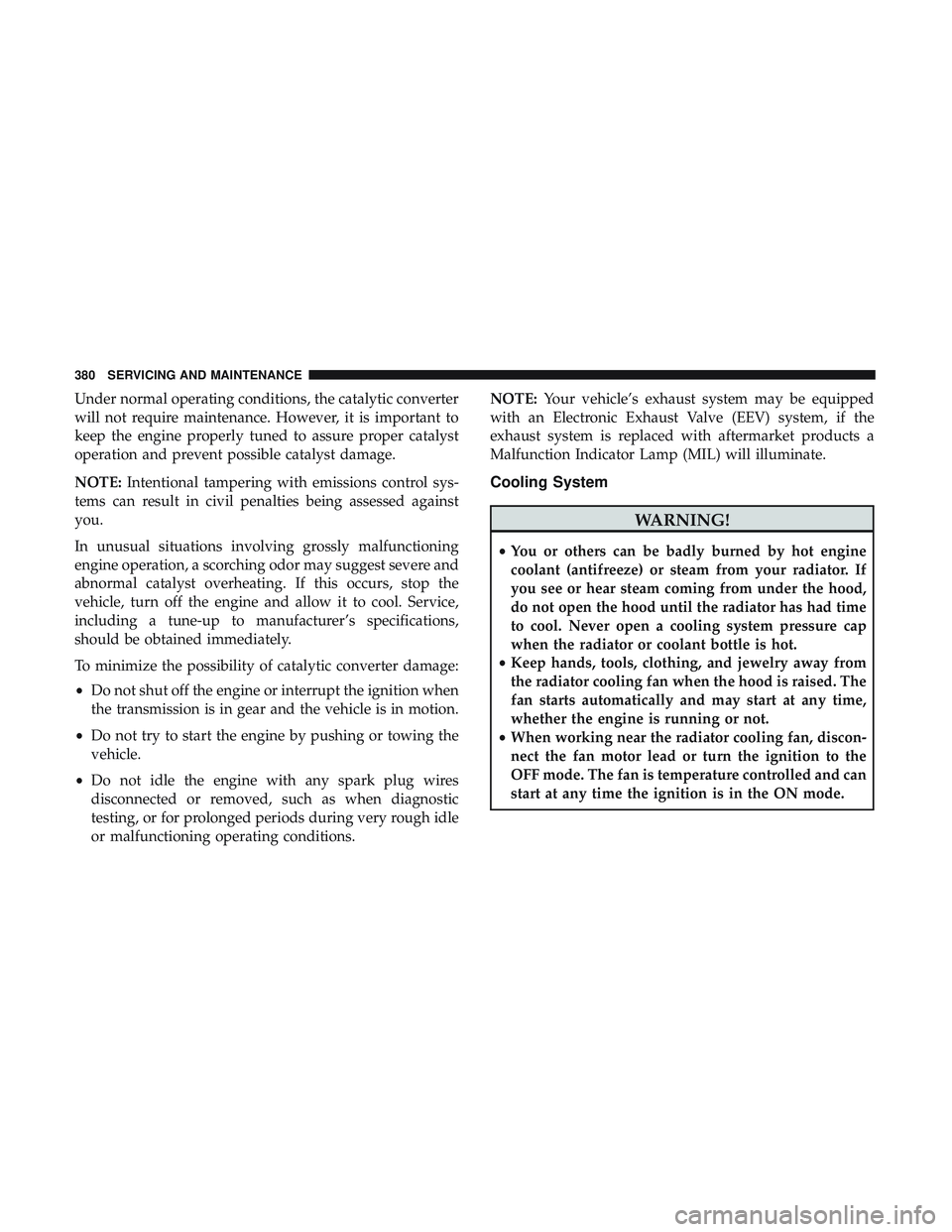
Under normal operating conditions, the catalytic converter
will not require maintenance. However, it is important to
keep the engine properly tuned to assure proper catalyst
operation and prevent possible catalyst damage.
NOTE:Intentional tampering with emissions control sys-
tems can result in civil penalties being assessed against
you.
In unusual situations involving grossly malfunctioning
engine operation, a scorching odor may suggest severe and
abnormal catalyst overheating. If this occurs, stop the
vehicle, turn off the engine and allow it to cool. Service,
including a tune-up to manufacturer’s specifications,
should be obtained immediately.
To minimize the possibility of catalytic converter damage:
• Do not shut off the engine or interrupt the ignition when
the transmission is in gear and the vehicle is in motion.
• Do not try to start the engine by pushing or towing the
vehicle.
• Do not idle the engine with any spark plug wires
disconnected or removed, such as when diagnostic
testing, or for prolonged periods during very rough idle
or malfunctioning operating conditions. NOTE:
Your vehicle’s exhaust system may be equipped
with an Electronic Exhaust Valve (EEV) system, if the
exhaust system is replaced with aftermarket products a
Malfunction Indicator Lamp (MIL) will illuminate.
Cooling System
WARNING!
• You or others can be badly burned by hot engine
coolant (antifreeze) or steam from your radiator. If
you see or hear steam coming from under the hood,
do not open the hood until the radiator has had time
to cool. Never open a cooling system pressure cap
when the radiator or coolant bottle is hot.
• Keep hands, tools, clothing, and jewelry away from
the radiator cooling fan when the hood is raised. The
fan starts automatically and may start at any time,
whether the engine is running or not.
• When working near the radiator cooling fan, discon-
nect the fan motor lead or turn the ignition to the
OFF mode. The fan is temperature controlled and can
start at any time the ignition is in the ON mode.
380 SERVICING AND MAINTENANCE
Page 383 of 553
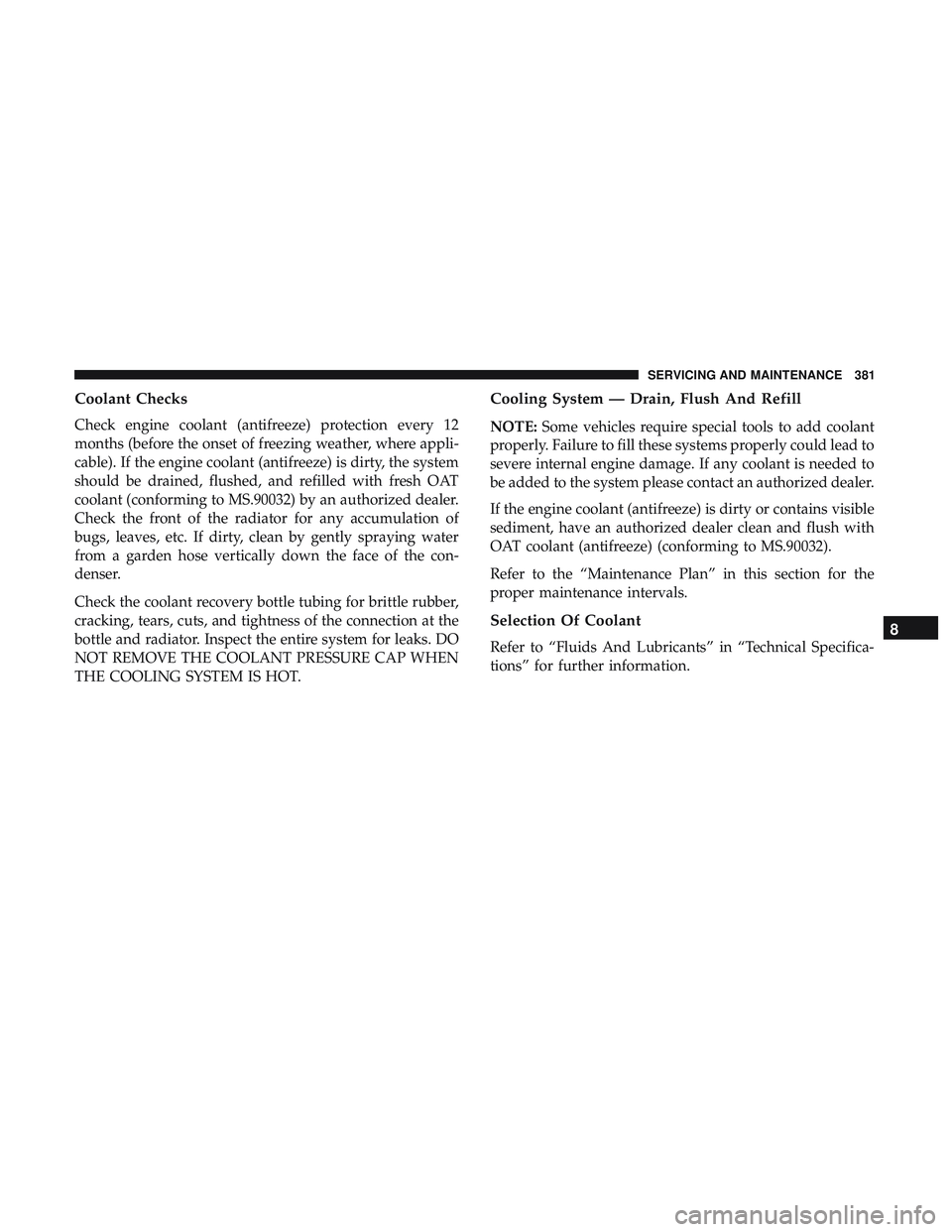
Coolant Checks
Check engine coolant (antifreeze) protection every 12
months (before the onset of freezing weather, where appli-
cable). If the engine coolant (antifreeze) is dirty, the system
should be drained, flushed, and refilled with fresh OAT
coolant (conforming to MS.90032) by an authorized dealer.
Check the front of the radiator for any accumulation of
bugs, leaves, etc. If dirty, clean by gently spraying water
from a garden hose vertically down the face of the con-
denser.
Check the coolant recovery bottle tubing for brittle rubber,
cracking, tears, cuts, and tightness of the connection at the
bottle and radiator. Inspect the entire system for leaks. DO
NOT REMOVE THE COOLANT PRESSURE CAP WHEN
THE COOLING SYSTEM IS HOT.
Cooling System — Drain, Flush And Refill
NOTE:Some vehicles require special tools to add coolant
properly. Failure to fill these systems properly could lead to
severe internal engine damage. If any coolant is needed to
be added to the system please contact an authorized dealer.
If the engine coolant (antifreeze) is dirty or contains visible
sediment, have an authorized dealer clean and flush with
OAT coolant (antifreeze) (conforming to MS.90032).
Refer to the “Maintenance Plan” in this section for the
proper maintenance intervals.
Selection Of Coolant
Refer to “Fluids And Lubricants” in “Technical Specifica-
tions” for further information.
8
SERVICING AND MAINTENANCE 381
Page 385 of 553
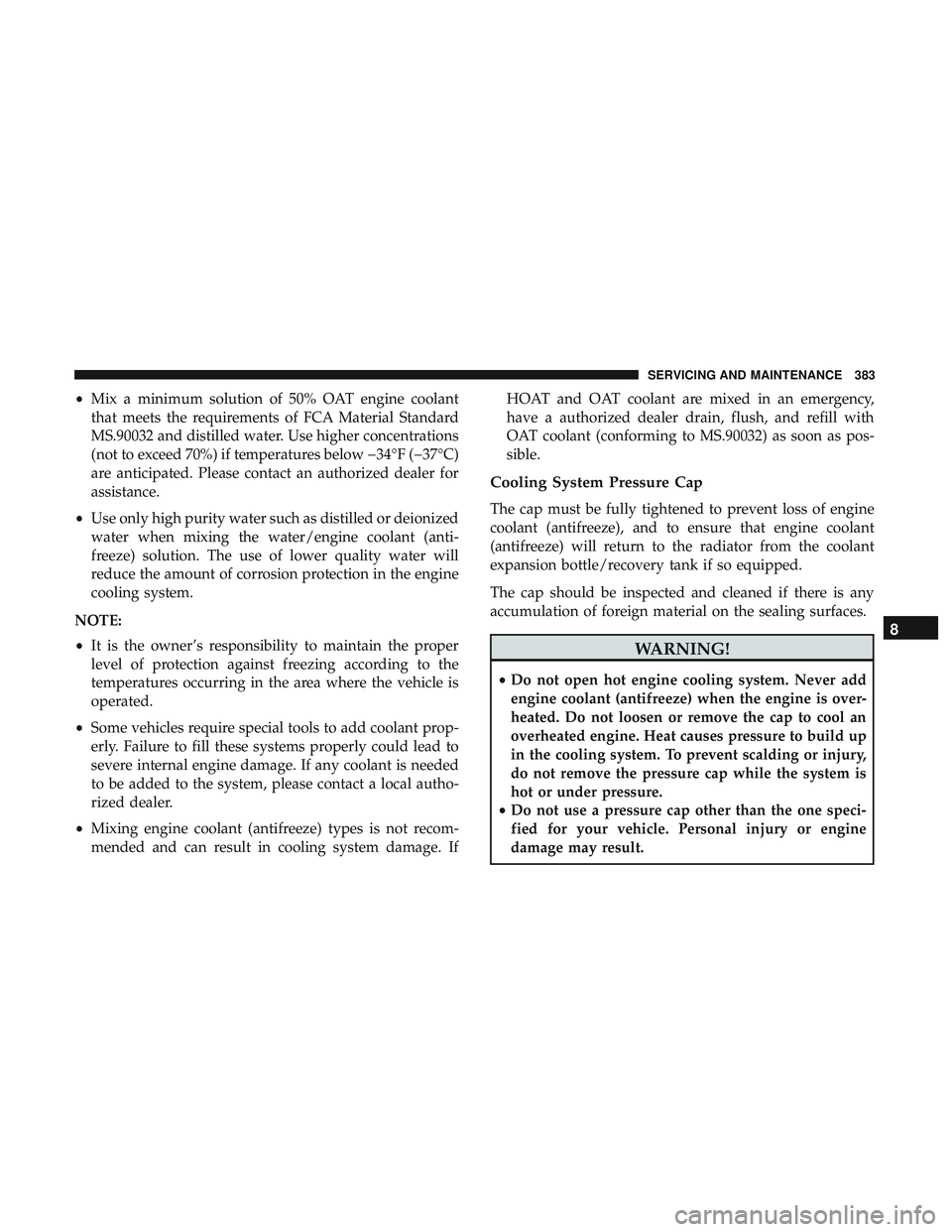
•Mix a minimum solution of 50% OAT engine coolant
that meets the requirements of FCA Material Standard
MS.90032 and distilled water. Use higher concentrations
(not to exceed 70%) if temperatures below �34°F (�37°C)
are anticipated. Please contact an authorized dealer for
assistance.
• Use only high purity water such as distilled or deionized
water when mixing the water/engine coolant (anti-
freeze) solution. The use of lower quality water will
reduce the amount of corrosion protection in the engine
cooling system.
NOTE:
• It is the owner’s responsibility to maintain the proper
level of protection against freezing according to the
temperatures occurring in the area where the vehicle is
operated.
• Some vehicles require special tools to add coolant prop-
erly. Failure to fill these systems properly could lead to
severe internal engine damage. If any coolant is needed
to be added to the system, please contact a local autho-
rized dealer.
• Mixing engine coolant (antifreeze) types is not recom-
mended and can result in cooling system damage. If HOAT and OAT coolant are mixed in an emergency,
have a authorized dealer drain, flush, and refill with
OAT coolant (conforming to MS.90032) as soon as pos-
sible.
Cooling System Pressure Cap
The cap must be fully tightened to prevent loss of engine
coolant (antifreeze), and to ensure that engine coolant
(antifreeze) will return to the radiator from the coolant
expansion bottle/recovery tank if so equipped.
The cap should be inspected and cleaned if there is any
accumulation of foreign material on the sealing surfaces.
WARNING!
•
Do not open hot engine cooling system. Never add
engine coolant (antifreeze) when the engine is over-
heated. Do not loosen or remove the cap to cool an
overheated engine. Heat causes pressure to build up
in the cooling system. To prevent scalding or injury,
do not remove the pressure cap while the system is
hot or under pressure.
• Do not use a pressure cap other than the one speci-
fied for your vehicle. Personal injury or engine
damage may result.
8
SERVICING AND MAINTENANCE 383
Page 386 of 553
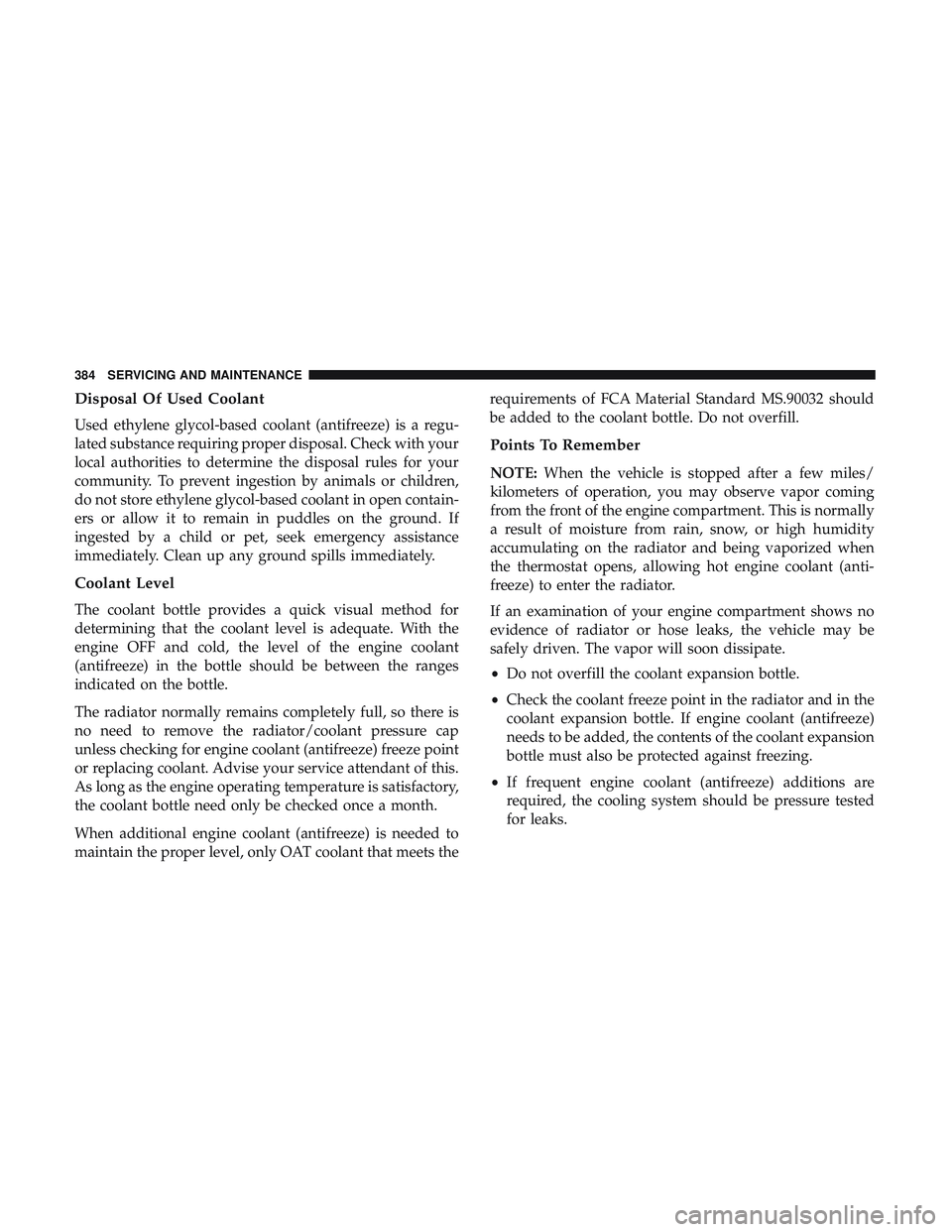
Disposal Of Used Coolant
Used ethylene glycol-based coolant (antifreeze) is a regu-
lated substance requiring proper disposal. Check with your
local authorities to determine the disposal rules for your
community. To prevent ingestion by animals or children,
do not store ethylene glycol-based coolant in open contain-
ers or allow it to remain in puddles on the ground. If
ingested by a child or pet, seek emergency assistance
immediately. Clean up any ground spills immediately.
Coolant Level
The coolant bottle provides a quick visual method for
determining that the coolant level is adequate. With the
engine OFF and cold, the level of the engine coolant
(antifreeze) in the bottle should be between the ranges
indicated on the bottle.
The radiator normally remains completely full, so there is
no need to remove the radiator/coolant pressure cap
unless checking for engine coolant (antifreeze) freeze point
or replacing coolant. Advise your service attendant of this.
As long as the engine operating temperature is satisfactory,
the coolant bottle need only be checked once a month.
When additional engine coolant (antifreeze) is needed to
maintain the proper level, only OAT coolant that meets therequirements of FCA Material Standard MS.90032 should
be added to the coolant bottle. Do not overfill.
Points To Remember
NOTE:
When the vehicle is stopped after a few miles/
kilometers of operation, you may observe vapor coming
from the front of the engine compartment. This is normally
a result of moisture from rain, snow, or high humidity
accumulating on the radiator and being vaporized when
the thermostat opens, allowing hot engine coolant (anti-
freeze) to enter the radiator.
If an examination of your engine compartment shows no
evidence of radiator or hose leaks, the vehicle may be
safely driven. The vapor will soon dissipate.
• Do not overfill the coolant expansion bottle.
• Check the coolant freeze point in the radiator and in the
coolant expansion bottle. If engine coolant (antifreeze)
needs to be added, the contents of the coolant expansion
bottle must also be protected against freezing.
• If frequent engine coolant (antifreeze) additions are
required, the cooling system should be pressure tested
for leaks.
384 SERVICING AND MAINTENANCE
Page 387 of 553
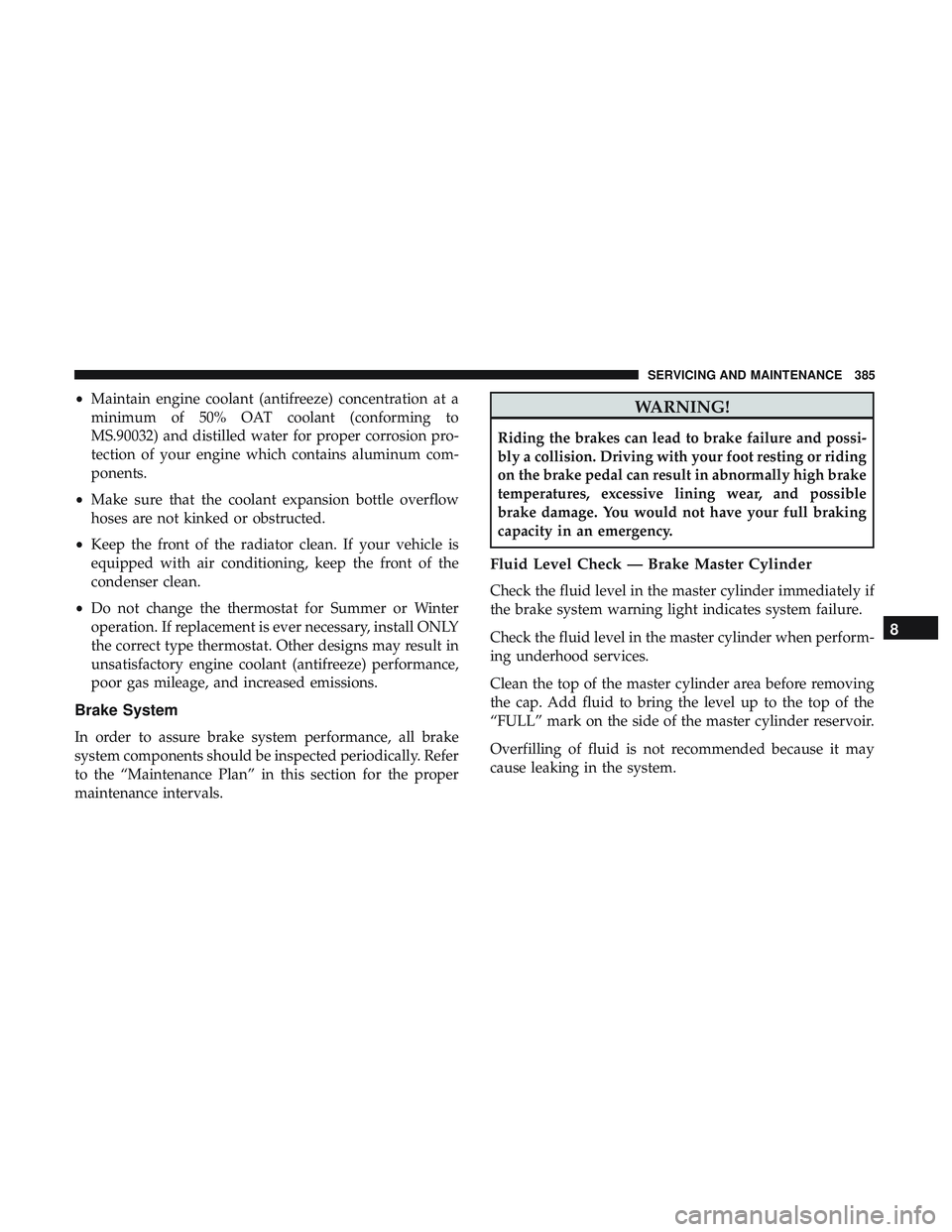
•Maintain engine coolant (antifreeze) concentration at a
minimum of 50% OAT coolant (conforming to
MS.90032) and distilled water for proper corrosion pro-
tection of your engine which contains aluminum com-
ponents.
• Make sure that the coolant expansion bottle overflow
hoses are not kinked or obstructed.
• Keep the front of the radiator clean. If your vehicle is
equipped with air conditioning, keep the front of the
condenser clean.
• Do not change the thermostat for Summer or Winter
operation. If replacement is ever necessary, install ONLY
the correct type thermostat. Other designs may result in
unsatisfactory engine coolant (antifreeze) performance,
poor gas mileage, and increased emissions.
Brake System
In order to assure brake system performance, all brake
system components should be inspected periodically. Refer
to the “Maintenance Plan” in this section for the proper
maintenance intervals.
WARNING!
Riding the brakes can lead to brake failure and possi-
bly a collision. Driving with your foot resting or riding
on the brake pedal can result in abnormally high brake
temperatures, excessive lining wear, and possible
brake damage. You would not have your full braking
capacity in an emergency.
Fluid Level Check — Brake Master Cylinder
Check the fluid level in the master cylinder immediately if
the brake system warning light indicates system failure.
Check the fluid level in the master cylinder when perform-
ing underhood services.
Clean the top of the master cylinder area before removing
the cap. Add fluid to bring the level up to the top of the
“FULL” mark on the side of the master cylinder reservoir.
Overfilling of fluid is not recommended because it may
cause leaking in the system.
8
SERVICING AND MAINTENANCE 385
Page 538 of 553
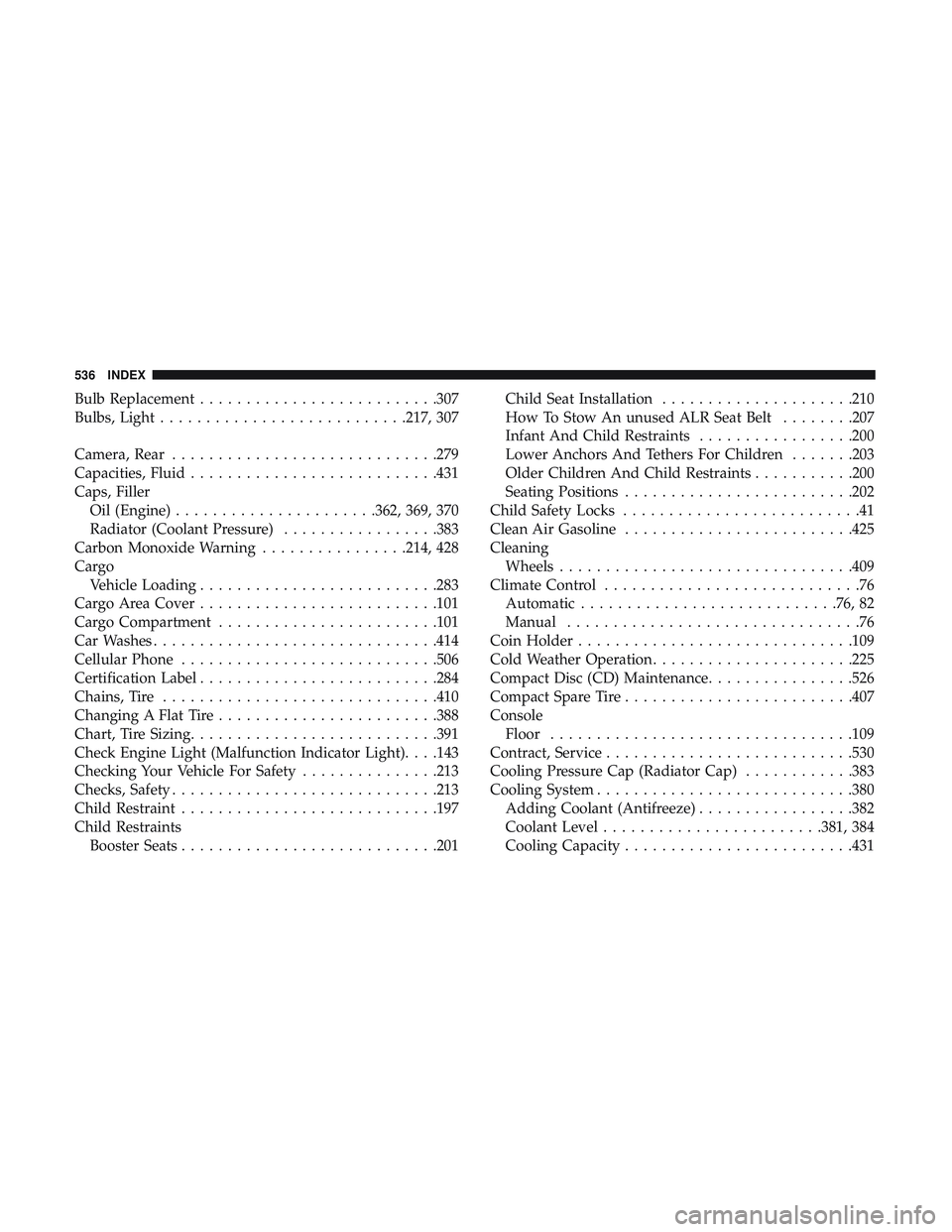
Bulb Replacement..........................307
Bulbs, Light .......................... .217, 307
Camera, Rear ............................ .279
Capacities, Fluid .......................... .431
Caps, Filler Oil (Engine) ..................... .362, 369, 370
Radiator (Coolant Pressure) .................383
Carbon Monoxide Warning ................214, 428
Cargo Vehicle Loading ..........................283
Cargo Area Cover ..........................101
Cargo Compartment ........................101
Car Washes ...............................414
Cellular Phone ............................506
Certification Label ..........................284
Chains, Tire ............................. .410
Changing A Flat Tire ........................388
Chart, Tire Sizing .......................... .391
Check Engine Light (Malfunction Indicator Light). . . .143
Checking Your Vehicle For Safety ...............213
Checks, Safety ............................ .213
Child Restraint ............................197
Child Restraints Booster Seats ............................201 Child Seat Installation
.....................210
How To Stow An unused ALR Seat Belt ........207
Infant And Child Restraints .................200
Lower Anchors And Tethers For Children .......203
Older Children And Child Restraints ...........200
Seating Positions ........................ .202
Child Safety Locks ..........................41
Clean Air Gasoline ........................ .425
Cleaning Wheels ............................... .409
Climate Control ............................76
Automatic ............................76, 82
Manual ................................76
Coin Holder ............................. .109
Cold W
eather Operation ..................... .225
Compact Disc (CD) Maintenance ................526
Compact Spare Tire ........................ .407
Console Floor .................................109
Contract, Service .......................... .530
Cooling Pressure Cap (Radiator Cap) ............383
Cooling System ............................380
Adding Coolant (Antifreeze) .................382
Coolant Level ........................381, 384
Cooling Capacity ........................ .431
536 INDEX
Page 539 of 553
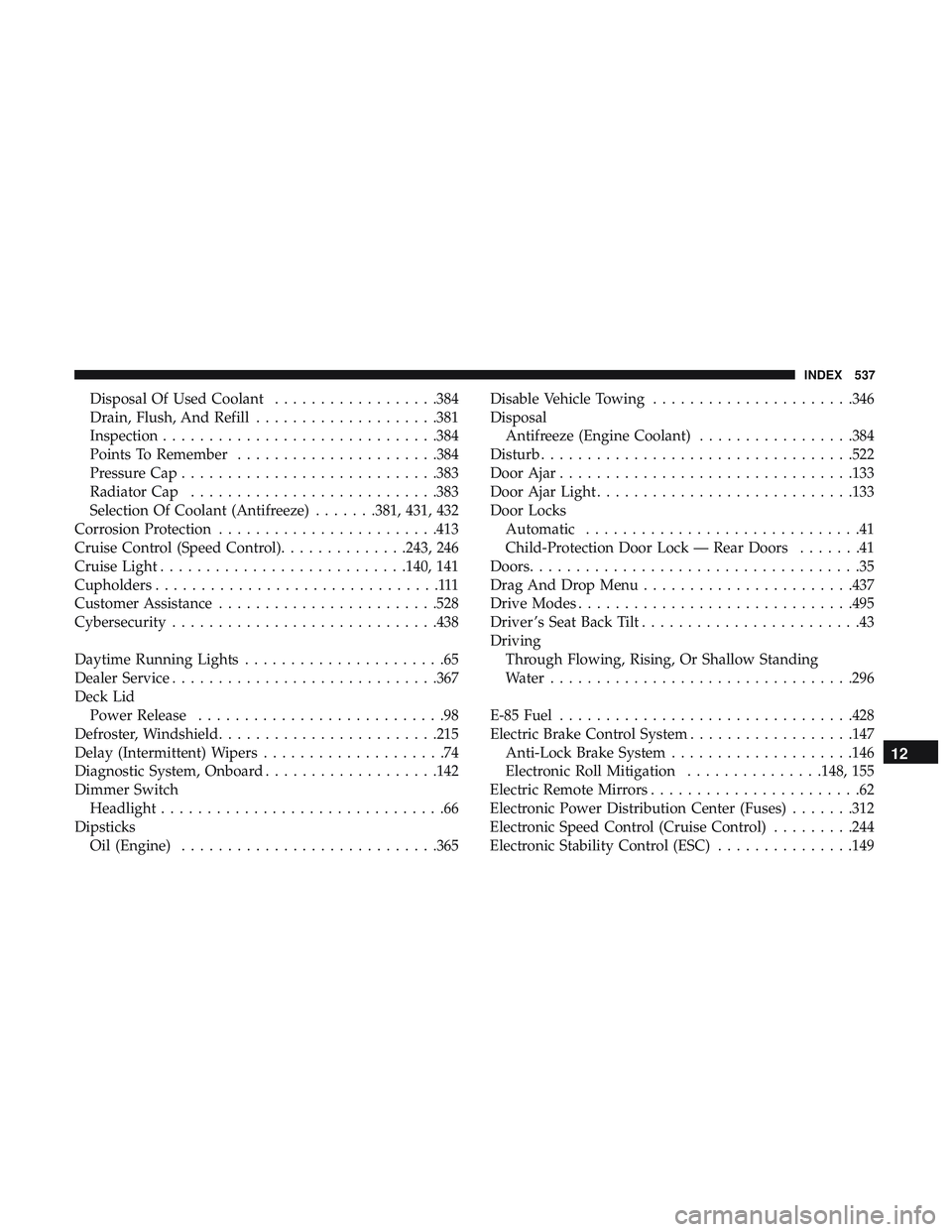
Disposal Of Used Coolant..................384
Drain, Flush, And Refill ....................381
Inspection ............................. .384
Points To Remember ..................... .384
Pressure Cap ............................383
Radiator Cap .......................... .383
Selection Of Coolant (Antifreeze) .......381, 431, 432
Corrosion Protection ........................413
Cruise Control (Speed Control) ..............243, 246
Cruise Light .......................... .140, 141
Cupholders ...............................111
Customer Assistance ........................528
Cybersecurity ............................ .438
Daytime Running Lights ......................65
Dealer Service ............................ .367
Deck Lid Power Release ...........................98
Defroster, Windshield ........................215
Delay (Intermittent) Wipers ....................74
Diagnostic System, Onboard ...................142
Dimmer Switch Headlight ...............................66
Dipsticks Oil (Engine) ............................365 Disable Vehicle Towing
..................... .346
Disposal Antifreeze (Engine Coolant) .................384
Disturb ................................. .522
Door Ajar ............................... .133
Door Ajar Light ............................133
Door Locks Automatic ..............................41
Child-Protection Door Lock — Rear Doors .......41
Doors ....................................35
Drag And Drop Menu .......................437
Drive Modes ............................. .495
Driver ’s Seat Back Tilt ........................43
Driving Through Flowing, Rising, Or Shallow Standing
Water .................................296
E-85 Fuel ............................... .428
Electric Brake Control System ..................147
Anti-Lock Brake
System ....................146
Electronic Roll Mitigation ...............148, 155
Electric Remote Mirrors .......................62
Electronic Power Distribution Center (Fuses) .......312
Electronic Speed Control (Cruise Control) .........244
Electronic Stability Control (ESC) ...............149
12
INDEX 537
Page 546 of 553

Recline.................................46
Power Steering Fluid ........................432
Pregnant Women And Seat Belts ................181
Preparation For Jacking ..................... .325
Pretensioners Seat Belts ............................. .181
Radial Ply Tires ............................401
Radiator Cap (Coolant Pressure Cap) .............383
Radio Frequency General Information ................25, 31, 33, 41
Radio Operation .......................... .506
Rain Sensitive Wiper System ...................74
Rear Axle (Differential) ..................... .388
Rear Camera ............................. .279
Rear Cross Path ............................161
Rear ParkSense System ..................... .267
Rear Seats, Folding ..........................53
Rear Wheel Drive Towing ............................... .349
Recreational Towing ........................ .295
Reformulated Gasoline .......................425
Refrigerant ...............................372
Release, Hood ..............................97
Reminder, Lights On .........................68 Reminder, Seat Belt
........................ .174
Remote Keyless Entry Arm The Alarm ..........................33
Panic Alarm .............................20
Programming Additional Key Fobs ..........24, 32
Unlatch The Trunk ........................20
Remote Starting Exit Remote Start Mode .....................30
Uconnect Customer Programmable Features ......31
Uconnect Settings .........................31
Remote Trunk Release ........................98
Replacement Bulbs ........................ .307
Replacement Keys ........................24, 32
Replacement Tires ..........................404
Reporting Safety Defects .....................531
Restraints, Child .......................... .197
Restraints, Head .......................54, 55, 56
Rocking Vehicle When Stuck ...................345
Rotation, T
ires.............................411
RWD Towing ............................... .349
Safety Checks Inside Vehicle ...................215
Safety Checks Outside Vehicle .................217
Safety Defects, Reporting .....................531
544 INDEX